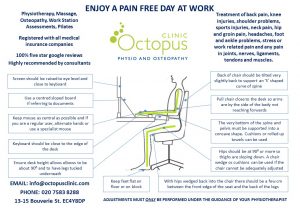Sitting posture
Sitting posture at work, at home or in the car is a major cause or cure of pain in the back, shoulders, neck, arms and knees. Please scroll down to the bottom for specific advice on how to adjust your posture in the car to avoid or reduce pain.
Sitting posture at work
Ask your colleague to take photos of the way you naturally sit at work with a digital camera or smart phone. Take pictures from the side and from the back including your feet, legs, back, head and hands. Then take it in for your Physiotherapist or Osteopath to see, who will then advice you on how to make changes specific to your body.
You can do the same with a friend or family member for sitting in the car or sitting at home watching TV! However, the following generic advice will give you a good start.

Sitting posture in the office or at home:
-
The most important thing is to adjust the height of your chair so that your hips are slightly higher than your knees and your thighs are slanting downwards
-
The next most important aspect is to make sure the very base of your spine is properly supported so that your pelvis is in neutral, i.e. slightly tilted forwards and the bottom of your back is concave. Most chairs do not do this so use pillows or towels to provide this support.
-
Make sure your feet are firmly on the floor – you may need a small foot stool or a few large books can do the trick too! Train yourself to get out of the habit of crossing your legs!
-
Move your buttocks into the back of the chair. There should be a gap between the back of your knees and the edge of the seat so if you have shorter thighs you may need a different chair.
-
Your upper and mid back should not be concave – they should actually be slightly convex which is normally achieved by simply leaning against the back rest.
-
Make sure your head does not drift forwards and down with gravity – please click here to learn more about correct neck posture.
-
Move your chair so that your legs are under the desk and your body is right up to the edge of the desk.
-
Your elbows should be by your sides – not in front of you – and at about a 90 degree angle.
-
Your keypad should be a few cms from the edge of the desk so that your wrists rest on the edge of the desk with the fingers extending onto the keyboard without having to bend your wrists up or down.
-
The mouse should be as close to you as possible so that you are not reaching at all with the arm.
-
If you lean back in your chair and reach forwards you should be able to touch the screen of your PC.
-
If you absolutely have to use a laptop buy a small keyboard to plug into it, so that you can raise the laptop like a PC screen and use the keyboard separately.
-
If you have paperwork that you are referring to regularly dont put it to the side – use a slanted paper holder between your screen and keyboard.
-
Your body is not designed to be in one position for prolonged period so get up and walk around regularly. Click here to learn an excellent way of stretching your spine in a chair.
Sitting posture in the car
-
Raise and tilt the seat so that your hips are slightly higher than your knees and your thighs are slanting downwards. This is dependent on the type and size of your car, but just try to adjust it as much as possible!
-
Make sure you are supported so that your lower back is slightly concave and your pelvis is slightly tilted forwards – most car seats do not do this so you will need cushions or towels to achieve this.
-
Make sure your shoulders are flat against the back of the seat – you might need to tilt your seat into a more upright position and move your chair closer to the pedals to do achieve this.
-
Make sure your head rest allows you to rest your head gently against it whilst simultaneously tilting your chin in.
-
Your body is not designed to be in one position for prolonged periods so stop regularly to have a walk around
Please note that although the advice and exercises provided are designed to assist your recovery they are not a replacement for seeing a Physiotherapist or Osteopath. It is essential that you always make sure you see your Doctor, Osteopath or Chartered Physiotherapist beforehand to diagnose your injury and guide you through recovery.